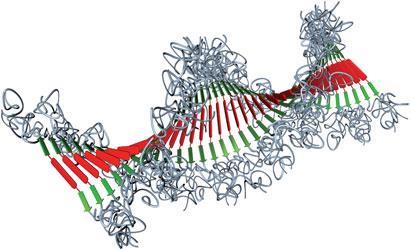Scientists have been able to control polymer self-assembly to get the nanowires they want
Scientists in Switzerland have controlled the supramolecular self-assembly of polymers to form nanofibrils that could be used as organic nanowires in electronic devices. Supramolecular self-assembly often relies on trial and error - the polymerisation could go in any direction - so scientists have been looking for ways to control it to get the structure they want.
Holger Frauenrath at the Federal Polytechnic School in Lausanne and colleagues used molecular precursors that are capable of one-directional self-assembly. They prepared an oligopeptide from polymer segments attached to beta-sheet-forming oligopeptide segments, with a pi-conjugated segment at the centre. By carefully selecting the molecular precursors, the team ensured that non-covalent interactions promoted one-dimensional aggregation, while lateral aggregation was suppressed.
Frauenrath then used diacetylene compounds carrying oligopeptide-polymer substituents to deduce the parameters needed for successful self-assembly in a single direction. The team found that two factors were key: the length of the polymer segment and the number of hydrogen bonding sites in the oligopeptide segment.

The self-assembly is controlled by the beta-sheet formation of the oligopeptide, owing to hydrogen bonding interactions between two molecular partners; the team found that a minimum of 4+4 hydrogen bonding sites is required for aggregation to form well-defined stable nanofibrils. They also found it necessary to use between 10 and 20 polymer chain lengths; any more than this and aggregation was disrupted, even when the number of hydrogen bonding sites on the oligopeptide was increased. The team put this down to the increase in entropy as the chain extends quickly, overcoming the force of attraction between the hydrogen bonding partners.
The team then switched the pi-conjugated segment from diacetylene to a p-type semiconducting segment and an n-type semiconducting segment and successfully applied the same method. According to John Tovar, an expert in supramolecular polymer chemistry and particularly incorporation of pi-conjugated molecules at Johns Hopkins University, US, this systematic tuning of the molecular fragments means that Frauenrath and co-workers have made ’an important structure-function contribution’ that paves the way for rational and predictable construction of functional supramolecular electronic materials.
Andrea McGhee
References
L Tian et alChem. Sci., 2012, DOI: 10.1039/<man>c2sc00977c</man>






No comments yet